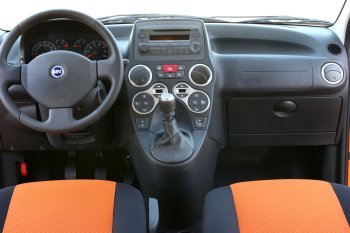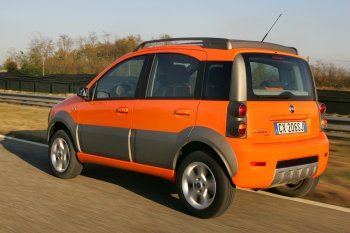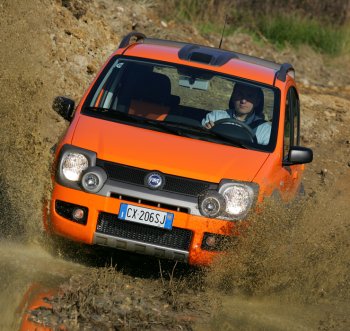|
oFFROAD SPIRIT AND MECHANICAL SYSTEMS
|
|
Stylish good
looks and the mechanical configuration of a true off-roader.
This, to sum up, is the spirit of the new model that builds
on the extraordinary success of the first Panda 4x4 while
also setting out to become the benchmark in this particular
market band due to its sophisticated style, carefully honed
details and wealth of features. The car therefore offers a
four wheel drive system that engages automatically when the
front wheels lose grip. The Panda Cross is therefore an
extraordinary explorer that is entirely at ease over
unsurfaced, difficult terrain, as evidenced by the ramp
angles in standard A. First and foremost, the 'incidence'
angle, which measures the maximum front angle that may be
tackled by an off-road vehicle without the body touching the
ground. The second value is the 'rear' incidence angle, i.e.
the maximum slope that can be taken in reverse starting from
a horizontal surface. The last one is the slope angle, i.e.
the maximum possible angle at the base of the triangular
slope (isosceles) that the car can be driven up without its
bottom touching the ground. The values for the SUV
specification of the new model are as follows: 24° (front),
42° (rear) and 24° (slope). The maximum climbable gradient
is more than 50%.
The Panda 4x4 also offers a host of dynamic and comfort
features that allow it to tackle long and demanding routes
in comfort, due in particular to its suspension layout and
special tyres. The Panda Cross is fitted with tyres (175/65
R15) that achieve the best balance between road performance
(handling land comfort) and off-road performance (over
unsurfaced roads) and winter performance (over snowy
surfaces). The 175/65R15 tyre cannot be fitted with snow
chains while alloy wheels come as standard.
Four wheel drive
Four wheel drive (4WD) means that all four wheels are
driven; offering the benefit that twice the torque of a two
wheel drive (2WD) can be discharged to the ground,
particularly on slippery surfaces. In other words, the 4x4
transmission doubles the drive force discharged to the
ground and means that the vehicle can overcome considerable
differences in level or steep and difficult terrain while
also propelling the vehicle forward if two drive wheels are
not enough, e.g. over an icy or snow-covered road surface.
The configuration chosen for the Panda 4x4 is a four wheel
drive transmission with two differentials and a viscous
coupling. With this system, the four wheel drive is engaged
automatically (i.e. without requiring any engagement by the
driver) and allows outstanding drive torque distribution
over the front and rear axle according to the road surface
and vehicle application requirements. For example, on
asphalt roads with normal grip, 98% of the drive torque is
directed to the front wheels so that the car can behave in a
similar way to a front wheel drive vehicle with equally
satisfying handling. It also provides excessive fuel and
tyre consumption due to small differences in rotating speed
between the front and rear wheels. The Fiat Panda 4x4 is
also equipped with an antislip system that operates during
deceleration by exploiting the potential of the ABS system
(i.e. making use of the sensors that record wheel rpm) and
the electronic engine control system to prevent the engine
braking torque and the viscous coupling from causing the
rear end to lock during sudden decelerations on downhill
slopes or on bends. Together with the four wheel drive
system, this ensures great driving safety over slippery
surfaces.
Lastly, the Panda 4x4 drive system makes full use of the
viscous coupling that forms an integral part of the rear
differential unit. The advantage of this configuration is
that the drive system is engaged in a relatively immediate,
automatic fashion to offer traction and effort when
difficult road surface conditions make this necessary. Now
it is time to take a closer look at the way a viscous
coupling works. The devices contain a set of perforated or
slightly finned discs submerged in a viscous fluid with very
specific properties: as the temperature rises, fluid
viscosity increases. When the two driven axles slip, they
stir up this fluid and cause its temperature to increase. As
soon as the temperature rises, the fluid becomes more
viscous and tends to drag the discs together and transmit
drive torque to the rear axle. This is a striking and clever
piece of engineering because the oil acts as a sensor, i.e.
it detects the presence of slip between the axles by its
temperature - and also as an actuator because it tends to
counteract the slipping effect by increasing its viscosity.
Locking Differential function
For the first time in the Panda 4x4 range, the SUV version
is fitted as standard with the LD (Locking Differential)
function that acts to brake slipping wheels and transfers
the torque to the other wheels on the same axis: for
example, during take-off over snowy, icy or muddy ground.
This function can also be activated manually and acts below
a threshold of 30 km/h (it disengages automatically over
this speed). Details of its operation are described below.
The system compares the speeds of the drive wheels on the
same axis and detects slip when the difference between both
wheels exceeds a threshold level. The speed is controlled by
applying braking torque to the slipping wheel. This is
achieved by increasing the pressure in the corresponding
branch of the brake circuit. This allows the differential to
transfer torque to the wheel with the best grip to get the
vehicle out of trouble.
The braking pressure on the individual wheel is increased by
activating the TC ISO and TC Supply valves in the hydraulic
circuit branch for the wheel to which the brake torque is to
be supplied, the pump motor and the ISO valve in the other
wheel on the same branch to which brake torque is not to be
applied.
The Locking Differential function can be engaged only at
speeds less than 30 km/h. If the vehicle exceeds this speed,
the function disengages automatically. The function remains
disengaged until it is next activated manually. Above this
speed, the Locking Differential does not intervene in order
to safeguard the braking system and viscous coupling against
overheating. The system disengages automatically even when
the control unit calculates that the brake temperature has
exceeded a given safety threshold and then cuts back in when
the brakes reach a safety temperature.
Front and rear suspension
The suspension system of a four wheel drive vehicle must
meet two main requirements. Firstly, it must ensure
passengers all the handling, roadholding and safety you
would expect from 2WD vehicles, while secondly it must
ensure greater pulling power over any route, particularly
off-road routes. To achieve both these aims, the engineers
adjusted these parameters to offer absolutely outstanding
performance with particular attention to off-road comfort
and performance. Hence the choice of two efficient tried and
tested layouts that work very effectively due to the
attributes of the chassis.
On the front, an
independent MacPherson configuration as adopted on the 2WD
version with certain changes. For example, the dimensions of
the shock absorbers are increased (bush rod 22mm instead of
20mm) to offer reliability and practicality even in the most
demanding off-road missions.
|

 |
|
 |
|
Compared to the
Panda 2WD, the four wheel drive version offers special
springs that add to the greater ground clearance so that the
vehicle can ride easily over any route and ground surface.
The technical specifications of the Panda 2WD front
suspension have been retained. The system therefore offers a
torsion bar connected to the shock absorber by means of bars
(a solution used to date only on higher segment cars). In
this case, the suspension ensures a greater ability to
filter out vibrations due to driving over rough ground and
has been improved by the adoption of:
-
new design
coil springs that increase the absorption of minor
surface roughness;
-
wishbones
with rubber and metal front bushes and new upright rear
bushes in rubber and metal; the latter contain a higher
volume of rubber and ensure an excellent compromise
between vibrational comfort and handling on corners by
means of differential radial stiffness;
-
mechanical
beam designed to accept the new wishbones and fitted
with body attachments without the interposition of
flexible elements;
-
double-acting telescopic hydraulic shock absorbers
(perform differently during compression and stretching)
located beneath the floor to improve comfort without
detracting from boot space.
Moving on to the
rear, the solution selected for the Panda 4x4 differs
significantly from that used on the 2WD model. Instead of an
interconnected wheel (semi-independent) suspension with a
torsion beam, the four wheel drive vehicle adopts a
configuration with longitudinal tie rods with independent
wheels. This layout ensures the support of the rear
differential (secured to the chassis with the interposition
of flexible elements), is designed to accept rear
transmission components (drive shafts) and ensures the rear
wheels the independence necessary to travel over any routes
or roughness.
In detail, a rear frame fastened rigidly to the body at four
points acts as a load sparing element for the rear
mechanical components (transmission and suspension). The tie
rods are also fastened to the frame with the interposition
of flexible elements (2 rubber/metal bushes per arm). The
axis of rotation of the arm (a virtual line that joins the
centre of both bushes) is inclined in space in order to
stabilise the wheel for safe roadholding under critical
stability conditions.
A torsion bar is fitted and connected to the tie rods by
means of ball joints that give the suspension extra rigidity
and stabilise it during rolling for safer performance on
bends.
Compared to the Panda 2WD, the size of the springs on the
four wheel drive version has been selected to give the
vehicle a raised ride (ground clearance) and thus allow it
to tackle any route and road surface. The position of the
shock absorbers, angled under the floorpan as on the two
wheel drive version, has been optimised to reduce hysteresis
during shocks and thus to increase the system filtering
capacity over ground roughness.
The revolutionary 70 bhp 1.3 Multijet
The Fiat Panda 4x4 range would not be complete without the
1.3 16v Multijet, the smallest, most advanced of the
second-generation Common Rail direct injection diesels. The
1.3 Multijet 16v is a 1248 cc 4 cylinder in line power unit
with a bore of just 69.6 mm and a 82 mm 'long' stroke. The
four valves per cylinder are driven directly by a twin
overhead camshaft. Maximum power output is 51 kW at 4000 rpm
(70 bhp) and the torque delivered is 145 Nm (14.8 kgm) at
just 1500 rpm.
The 1.3 Multijet 16v is a true masterpiece of miniaturised
technology: when clad with all its accessories, it weighs in
at just 130 kg. Its size is small at less than 50
centimetres in length and 65 in height. The component layout
has been designed to ensure it takes up the smallest
possible space. Yet it guarantees the same advantages as
bigger engines because it has not been reduced but
miniaturised. The power unit has thus been built to ensure
the greatest rationalism, efficiency and reliability and is
the smallest Common Rail four-cylinder diesel on the market.
The only one able to enclose no fewer than six normal-sized
components into a space of less that 70 millimetres: four
valves, one injector and one spark plug.
The new engine also adds another record to this major feat
of miniaturisation: it is the most powerful of its type.
Despite a truly miniscule cylinder capacity of 1248 cc, the
pocket Multijet came out top when compared with all the
small diesels with fixed geometry turbines currently present
on the market. Even the most vaunted. Suffice it to say that
it offers the best specific performance of any diesel engine
with 800 to 1500 cc of cylinder capacity: power output of 51
kW/l and torque of 145 Nm/l.
This compact, technologically sophisticated new engine also
offers outstanding efficiency and is practically guaranteed
for life. The 1.3 16v Multijet is in fact designed to last
250,000 km instead of the usual 150,000. During this long
lifetime, it does not require any maintenance to mechanical
parts (even the normally essential fan belt change at 80,000
km is not required). The oil change intervals have also been
increased from 20 to 30,000 km. The oil is naturally low
viscosity (i.e. designed for fuel economy) and
environmentally friendly.
And more. The 1.3 Multijet 16v is environmentally friendly
because it already meets Euro 4 emission limits not due to
come into force until 2006. It is also one of the very few
cars in the world that has been able to achieve this result
without the need for a sophisticated exhaust post-treatment
device such as a particulate trap. All in all, an
intrinsically clean car: the particulate emission level
(responsible for dust and fine dust) - for example - is even
lower than that established by the forthcoming Euro 4
standard. The 1.3 Multijet 16v therefore represents a true
technological leap that translates into a reduction in fuel
consumption and emissions for the customer. All this comes
with:
-
lower noise
levels (if we imagine the cylinder combustion to be like
striking a drum: striking a small drum three times is
less noisy than striking a large drum once);
-
greater
comfort: fewer alternating masses means less vibration;
-
smooth,
gentle drive due to outstanding torque progression (in
turn guaranteed by the possibility of greater control of
combustion, moment by moment);
-
the
flexibility and prompt responses of a diesel engine that
resembles petrol engines more and more due to its wide
rpm range (e.g. you no longer feel the fuel cut-off at
just over 4000 rpm);
-
environmentally-friendly features that allow this engine
to improve on the greenest feature of a diesel (fuel
consumption) by minimising its main defect (particulate
emissions).
The 70 bhp 1.3
16v Multijet engine is combined with a five-speed manual
gearbox able to transmit a torque of up to 14.8 kgm that
takes up little space and offers excellent selection lever
manoeuvrability. This has been achieved by reducing clutch
driven plate inertia and introducing new gaskets. The
gearbox configuration is transverse with two shafts in a
cascade, while the gear mechanism is internal over four
selection planes. The exterior mechanism is twin cable type
to filter out engine operating noise and vibrations
transmitted from engine to gear lever. The gear teeth offer
high meshing capacity while the fifth speed and final drive
gear sets are machined to a superfinish after heat treatment
(for lower noise levels). The gear casings are light and
very effective at absorbing noise. The gear cases are
developed using finite element structural computing methods.
The Panda Cross manual gearbox is also equipped with a
syringe mechanism to prevent involuntary reverse engagement. |
|